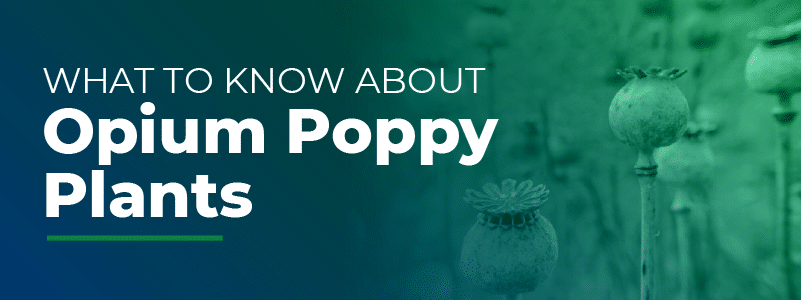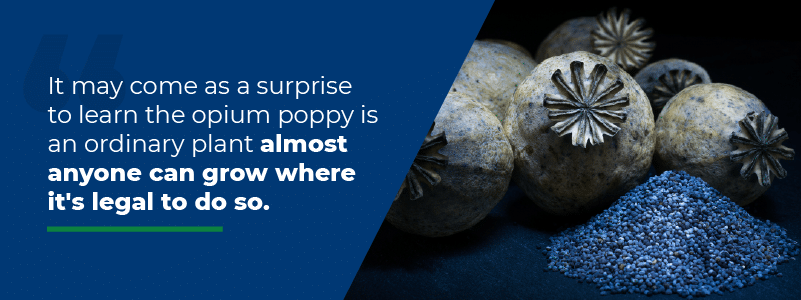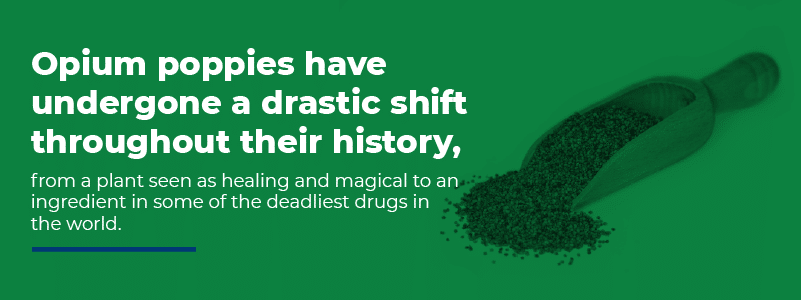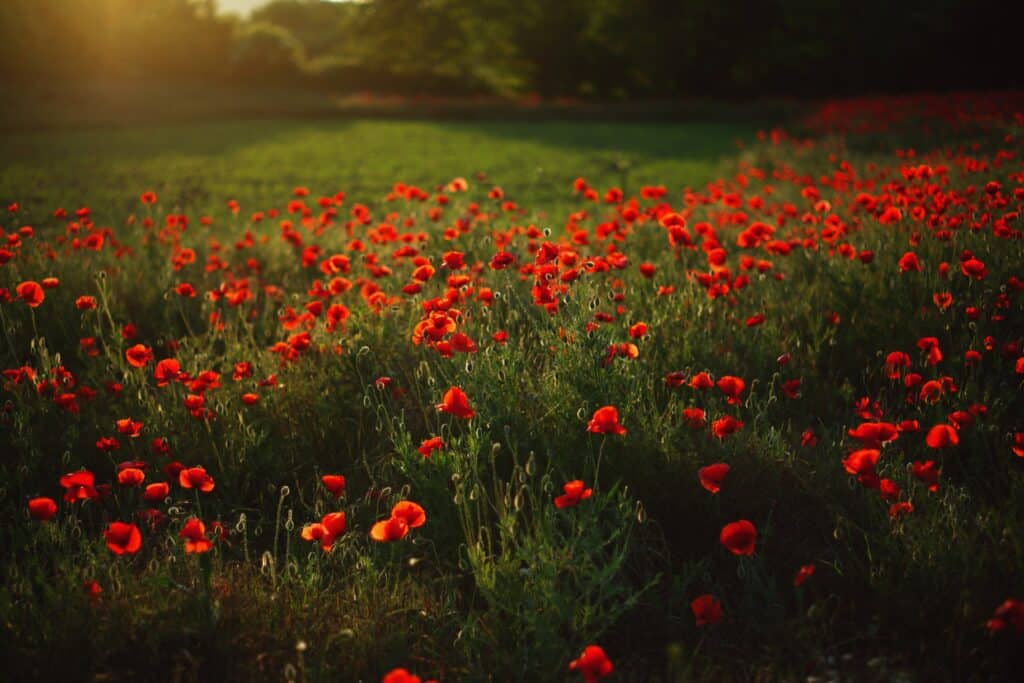As the American opioid crisis continues to grab headlines and impact a large subset of the population, people are becoming more interested in the origins of opioids. Although many of the most popular painkillers like hydrocodone and oxycodone are partially human-made, they also derive partly from opium. Opium has a long and complicated history among humans, but most people don’t fully understand how to harvest parts of the naturally occurring opium poppy and alter them to make powerful drugs such as morphine.

What Is an Opium Poppy?
“Opium poppies” is the name given to the flowering plant species Papaver somiferum, which means “sleep-bringing” in Latin. The flower is native to Western Asia and Southeastern Europe. The majority of opium poppies cultivated for their narcotic compounds grow in India and Turkey. However, farmers also grow poppies for ornamental purposes, as well as their edible seeds — the same ones you get on a bagel or in your morning muffin.
Do All Poppy Plants Have Opium?
The difference between your average poppy plant and an opium poppy is their level of alkaloids. Alkaloids are naturally occurring compounds in plants, which have an undeniable physiological effect on humans. The fewer alkaloids present, the less of a narcotic effect the plant provides. People generally select the varieties of poppy plants for ornamental use or production of seeds for their looks, meaning some barely have any alkaloids and others have the same alkaloid content as plants grown for opium.
Researchers recently uncovered two genes combined into one more than 7.8 million years ago, and that this “mega-gene” creates an enzyme that allows for the production of painkilling compounds. The gene codes the enzymes to work on a particular molecule in the poppy, which eventually changes into codeine or morphine. Without that gene, the precursor molecule would get converted into a compound called noscapine, and the poppy would contain no painkilling properties.
What Do Opium Poppy Plants Look Like?
If you’ve seen The Wizard of Oz, you can picture opium poppies. During their long, difficult journey, Dorothy and her companions get lulled to sleep while crossing a vast field of red poppies. These flowers can also come in shades of pink, purple, white and bi-colors. Poppies have five papery petals, and some varietals called “doubles” have many more petals.
The petals form the shape of a cup, with the flowers reaching up to four inches in diameter on large plants. A few days after blooming, petals of the opium poppy fall away, leaving their seed capsule behind. The green seed capsules grow up to the size of a golf ball, gradually turning brown over time. The capsules contain hundreds of seeds each, which the capsule releases through vents.

A History of Opium
It may come as a surprise to learn the opium poppy is an ordinary plant almost anyone can grow where it’s legal to do so. However, that fact led to the cultivation and use of this plant for thousands of years. Let’s take a look at some of the critical points in the long history of opium.
- 3400 BCE: Sumerians grow the opium poppy and refer to it as “Hul Gil,” the “joy plant.”
- 1300 BCE: Egyptians begin cultivating opium poppies, and the first opium trade war takes root.
- 460 BCE: Hippocrates, commonly known as “the father of medicine,” pivots the view of opium from a plant with magical origins to one with medicinal properties.
- 400 CE: Egyptian opium poppies make their way to China.
- 1300 CE: As the Inquisition takes hold, opium disappears from the record for 200 years, as Western religion considers all things from the East to be unholy.
- 1527: The Reformation brings opium back into European medical circles, calling it laudanum.
- 1750: Britain’s East India Company begins to dominate the trade of opium between India and China.
- 1799: China’s emperor bans opium trade and cultivation of poppies completely.
- 1803: Freidrich Sertuerner discovers opium’s active ingredient, thus inventing morphine.
- 1827: Merck starts manufacturing morphine commercially.
- 1841: Britain defeats China in the First Opium War, winning Hong Kong in the process.
- 1890: The United States Congress levies taxes on opium and morphine, and William Randolph Hearst begins a racially based propagandist campaign designed to link opium with “The Yellow Peril” of Chinese people.
- 1895: The Bayer Company discovers diluting morphine produces a drug that doesn’t have the common side effects of morphine. They call the new drug heroin and begin mass-producing it.
- 1905: After heroin addiction skyrockets in 1903, the United States bans opium.
- 1925: New York’s Chinatown becomes the scene of a flourishing opium black market.
- 1950s: In an attempt to contain Asian Communism, the U.S. and France team up with warlords and tribes located in opium-rich areas, which opens the floodgates for heroin to flow into the United States.
- 1973: President Richard Nixon creates the Drug Enforcement Administration.
- 1975: After the Vietnam War ends, opium producers look for new sources of raw materials and settle on Mexico’s Sierra Madre.
- 1978: The U.S. and Mexico team up to eliminate opium poppy fields with Agent Orange. In response, producers turn to the “Golden Crescent” of Iran, Afghanistan and Pakistan, still the origin of a significant portion of today’s opium poppies.
- 1982: Actor and comedian John Belushi dies from a “speedball” overdose involving both heroin and cocaine, bringing heroin into the public consciousness.
- 1992: Colombia becomes known for introducing the United States to a new, high-grade type of heroin.
- 1995: The “Golden Triangle,” including Burma, Laos, China, Cambodia and Vietnam, produces the most opium poppies at 2,500 tons each year.
- 2000s: The opioid crisis begins to pick up speed. Between 1991 and 2009, the number of prescriptions for opioids increased by 300%.

Opium poppies have undergone a drastic shift throughout their history, from a plant seen as healing and magical to an ingredient in some of the deadliest drugs in the world. Since the 2000s, American society has viewed opium solely through the lens of the drugs it produces: prescription painkillers and street drugs. The wars fought over this plant and its derivatives demonstrate the potent potential locked away in these average-looking flowers.
How Is Opium Made From Poppy Plants?
The collection of opium from poppy plants is straightforward and low-tech, which is why the drug has been in use for thousands of years. Though the process is time-consuming and tedious, anyone can do it. Opium itself is the milky substance that comes out of poppy seed pods before they ripen.
To collect the substance, you would slice the pod with a blade and collect the opium “gum” or resin. From there, it must dry in the open air to reach its final, consumable consistency. After the resin is dry, producers can pack and store it for future sale.
What About Morphine?
While users can consume the dried resin form of opium through smoking, and it has powerful effects on its own, its derivative morphine is significantly more concentrated and dangerous. Makeshift lab equipment is necessary to make morphine from opium.
Opium is mixed with lime and water to reach the desired mixture and pH level. The solution rests so the sediment can separate from the pure morphine. The morphine is skimmed off and mixed with other chemicals and water to result in a brown residue or paste on the cloth, which is morphine base, aka “Heroin No. 1.”
The morphine base represents about 10% of the original quantity of the raw materials, and people can abuse it as a drug on its own if they collect and smoke it. However, it is more often a stepping stone in the production of heroin.

How Do People Produce Heroin From Morphine?
It doesn’t take a full lab setup to turn morphine into heroin, which explains how so many rural farmers turn their poppy crops into the dangerous drug. The required equipment is low tech items, including a heat source, barrels and/or tubs, sacks, and filters. The chemical side of things is more complicated, requiring substances such as concentrated ammonia, acid and acetone, among others. These are the steps most heroin-makers follow in creating the drug, as observed by a team from the United Nations Office on Drugs and Crime.
- Acetic anhydride gets added to morphine base in a pot, and workers stir the solution until the morphine base dissolves. Then, they heat the solution and filter it through a cloth into an empty barrel.
- Heroin producers pour sodium carbonate solution until the heroin base precipitates out and doesn’t release any more gas. The resulting solution gets filtered multiple times until the brown heroin base becomes more concentrated.
- The brown heroin base dissolves in acid, and then workers stir in activated carbon and filter it out as many times as it takes to get a clear solution.
- Ammonia gets added to the clear solution, which then becomes white.
- The white heroin base gets mixed with more chemicals, then filtered and left to evaporate. The remaining dried substance is then ready for packaging and distribution.
The process boils down to a lot of mixing and filtering of substances, but many of the chemicals involved at each stage are incredibly hazardous to human health.
It’s also worth noting most heroin suppliers cut their product with other substances to maximize profits, so it’s common to find heroin mixed with sugar, flour, starch or even powdered milk. In more frightening cases, heroin dealers may use acetaminophen or fentanyl as cutting agents, resulting in a product even more dangerous than pure heroin itself.
Why Can People Buy Opium Poppy Plants?
You may have seen poppies growing in someone’s yard and wondered if they were legal. While it’s true you can find many varieties of poppy meant to decorate your garden, the Papaver somniferum poppy is highly illegal to buy or grow. The DEA defines the entire plant, save for the seeds, as opium, and has placed it on Schedule II. Other varieties of poppy, like Prickly Poppy and California Poppy, don’t fall under this definition.
It’s uncommon for people to try and grow opium poppies illegally, because the difficulty of getting your hands on the plants and the challenging extraction process make growing opium more trouble than it’s worth. However, some exceptional cases have come to light in recent years.
A Big Opium Poppy Bust
In 2017, one of the most notable opium busts of the last few decades happened in North Carolina. The grower, Cody Xiong, led investigators directly to his massive poppy crop entirely by accident.
According to The Washington Post, authorities arrived at Xiong’s door to conduct a “knock and talk” and didn’t even have a warrant to search the place. Investigators were there after receiving a tip about a completely unrelated matter, but Xiong opened the door and blurted, “I guess you are here for the opium.”
The stunned authorities later discovered about 2,000 pounds of poppies — an amount worth an estimated $500 million. Xiong had planted them in tidy rows and hidden them from view with a ring of trees on the property. The police charged Xiong with opium trafficking and manufacture of a Schedule II drug. Investigators believe Xiong intended to ship his crop off to somewhere else for processing into heroin.
He thought nobody would travel all the way down his dead-end road in the foothills, and he might have been right had he not immediately confessed to the crime of growing poppies.
Learn More About Opium, Methadone and Other Opioids
Opium and other drugs derived from the poppy plant are complex and worthy of investigation. Even if you haven’t struggled with addiction and don’t know anyone who has, it’s helpful to understand these powerful drugs. To learn more about opioids, their origins, and their effects on everyday lives, visit the MedMark blog. We work hard to answer the critical questions you have about opioids and addiction.
If you or someone you know is wrestling with an addiction to opioids, we invite you to learn more about MedMark’s treatment programs. We are proud to provide individuals with the gold standard of medication-assisted treatment, using the proven power of methadone to reduce cravings and withdrawals so you or your loved one can begin recovery safely.
To learn more about our programs and what they offer, call MedMark at 866.840.6658 or fill out our contact form. We look forward to helping you start your recovery on the right note.





